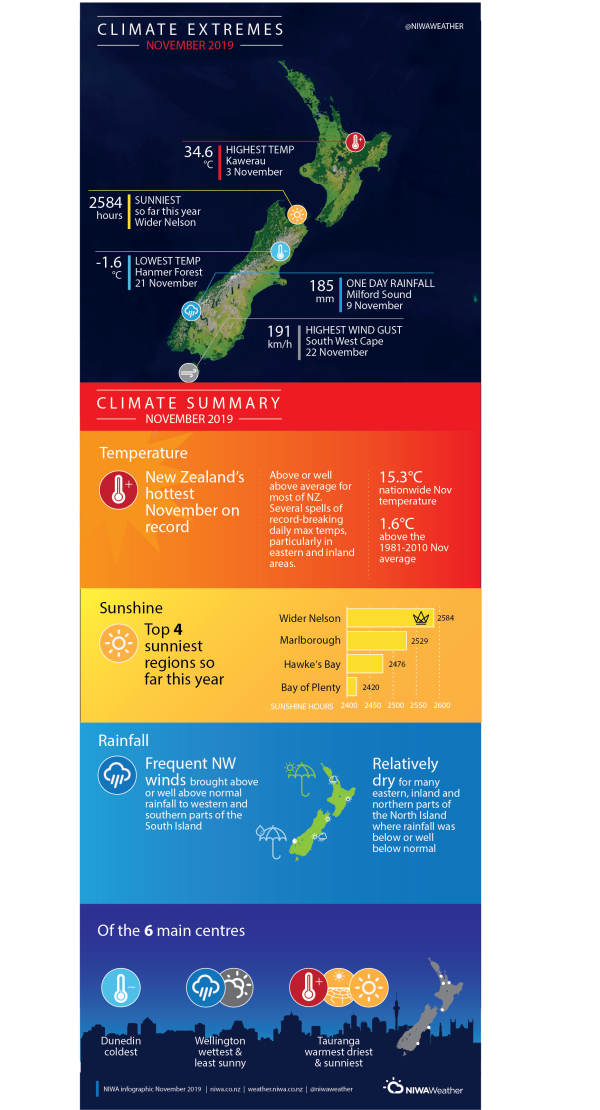Hottest November on record for New Zealand
|
Temperature |
The nationwide average temperature in November 2019 was 15.3°C (1.6°C above average) making it New Zealand’s hottest November on record. Temperatures were well above average (>1.20°C above average) or above average (0.51-1.20°C above average) for most of the country. The exception was parts of Fiordland and the West Coast where temperatures were near average (±0.50°C of the November average). |
|
Rainfall |
Rainfall was above normal (120-149% of normal) or well above normal (>149% of normal) in many western and southern parts of the South Island. In contrast, rainfall was below normal (50-79% of normal) or well below normal rainfall (<50% of normal) for many eastern, inland and northern parts of the North Island, eastern Marlborough and South Canterbury. |
|
Soil Moisture |
As of 1 December, soil moisture levels were lower than normal for much of Northland, Auckland, Waikato, Bay of Plenty, Hawke’s Bay and Wairarapa. Soils were wetter than normal for the time of year for parts of Southland and eastern Otago. |
Overview
November 2019 was characterised by lower than normal sea level pressure over the South Island, and considerably lower than normal sea level pressure to the south and south west of the country. This pressure setup resulted from the Southern Hemisphere storm tracks being displaced northwards across the entire Southern Ocean including towards New Zealand, leading to more northwesterlies than normal.
The persistent northwesterly winds delivered warm temperatures to much of the country overall, with several periods of unusually hot temperatures. On 3 November, Kawerau (Bay of Plenty) recorded a maximum temperature of 34.6°C; New Zealand’s third-highest November temperature on record. This temperature was especially notable considering how early in the month it occurred – extreme maximum November temperatures typically occur towards the end of the month as the daylight gets longer and sea surface temperatures around New Zealand increase. Overall, the nationwide average temperature in November 2019 was 15.3°C, making it New Zealand’s hottest November on record. This was 1.6°C above the 1981-2010 November average from NIWA’s seven station temperature series which begins in 1909. This is also substantially warmer than the previous national record for November of 15.1°C, shared by the years 2013 and 1954. Notably, four of New Zealand’s hottest ten Novembers have occurred since 2009. The record for the highest average daily maximum temperature at any location was also broken with Wairoa (Hawke’s Bay) recording an average daily maximum temperature for November of 26.2°C.
Rainfall was plentiful for many western and southern parts of the South Island, with persistent northwesterly winds delivering frequent rainfall along and near the Southern Alps. As a result, hydro lake storage levels increased dramatically during the month. In contrast, it was a relatively dry month for many eastern, inland and northern parts of the North Island, as well as eastern parts of Marlborough and South Canterbury. Several active frontal systems brought brief periods of very unsettled weather to the country, including hail for Auckland and Timaru, and a tornado in Christchurch (see Highlights and extreme events for further details). Dust and bushfire smoke that originated in Australia were transported over New Zealand by the prevailing northwest winds, bringing a light haze to the sky at times for parts of the country.
Further highlights
- The highest temperature was 34.6°C, observed at Kawerau on 3 November. This is New Zealand’s third-highest November temperature on record.
- The lowest temperature was -1.6°C, observed at Hanmer Forest on 21 November.
- The highest 1-day rainfall was 185 mm, recorded at Milford Sound on 9 November.
- The highest wind gust was 191 km/h, observed at South West Cape on 22 November.
- Of the six main centres in November 2019, Tauranga was the warmest, driest and sunniest, Wellington was the wettest and least sunny, and Dunedin was the coldest.
- Of the available, regularly reporting sunshine observation sites, the sunniest four locations in 2019 so far (1 January – 30 November) are Wider Nelson (2584 hours), Marlborough (2529 hours), Hawke’s Bay (2476 hours) and Bay of Plenty (2420 hours).


